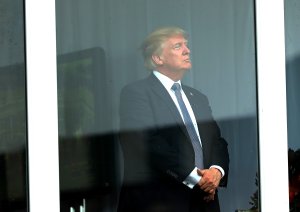When the Congressional Budget Office scored President Trump’s budget this week, some of the numbers came out looking different — very different.

The White House says its blueprint balances the budget over the next decade, reining in the deficit from $603 billion this year to a $16 billion surplus in 2027. But the CBO estimates a $720 billion deficit in 2027 — and more than double the cumulative deficit over the next 10 years.
So here’s the fundamental mismatch: The CBO says Trump’s budget math overestimated economic growth to the tune of $3.4 trillion in tax revenue over next decade.
Trump’s calculations rest on the assumption that real GDP will increase 3% year-over-year by 2020. But the CBO says not so fast. The nonpartisan agency pegs its estimate around 1.8% — much closer to the average rate over the last two decades.
“The deficits that CBO estimates would occur under the President’s proposals are larger than those estimated by the administration,” the report says. “Nearly all of that difference arises because the administration projects higher revenue collections — stemming mainly from a projection of faster economic growth.”
The report points to different “economic effects that the administration attributes to its proposals” as a main reason for the split. CBO’s estimate of the cumulative deficit over the next 10 years soars a whopping $3.7 trillion larger than Trump’s estimate – $6.84 trillion vs. $3.15 trillion.
On the campaign trail, Trump repeatedly touted the goal of reaching 3% growth in GDP — occasionally reaching even higher in his hopes. Most economic analysts — including Trump’s own Secretary of Commerce — believe this is an ambitious goal, especially in the next few years.
Here’s the detailed explanation of the differences from the report:
“In particular, CBO estimates that wages and salaries would be about $6.9 trillion (or 6%) lower than the administration projects, reducing CBO’s estimates of revenues from individual income and payroll taxes below those of the administration. In addition, CBO estimates that domestic economic profits would be about $3.2 trillion (or 15%) lower than the administration estimates, further reducing CBO’s estimates of revenues from corporate income taxes relative to those of the administration.”
What’s more, the CBO repeatedly said that it didn’t have the detail to analyze all the effects of the proposals Trump hopes to put into place.
“Because the details on many of the proposed policies are not available at this time, CBO cannot provide an analysis of all their macroeconomic effects or of the budgetary feedback that would result from those effects,” the reports says.
It goes on to say that the office usually gives an analysis of the big-picture effects of the White House’s policy proposals, but this year, “many of them did not contain the details necessary to assess those effects.”














